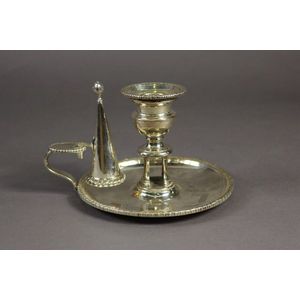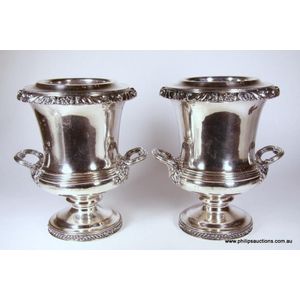Regency Sheffield Plate Wine Coolers
A pair of Regency Sheffield plate wine coolers, circa 1830, the fine urn style buckets with leafy shell cast rims, a reeded central section and handles embellished with grape vine embellishments, raised upon pedestal feet; with removable central sections enabling the body to be filled with ice. Height 27 cm
You must be a subscriber, and be logged in to view price and dealer details.
Subscribe Now to view actual auction price for this item
When you subscribe, you have the option of setting the currency in which to display prices to $Au, $US, $NZ or Stg.
This item has been sold, and the description, image and price are for reference purposes only.
- Sheffield Plate - Sheffield plate was the first commercially viable method of plating metal with silver. The method of plating was invented by Thomas Boulsover, a Sheffield Cutler, in 1743 and involved sandwiching an ingot of copper between two plates of silver, tightly binding it with wire, heating it in a furnace and then milling it out in to sheet, from which objects could be made.
Originally used by its inventor to make buttons, the potential of the material was quickly realised, and soon it was being used to fashion boxes, salvers and jugs, and not long after that candlesticks and coffee pots, and other traditional tableware.
Although there was a considerable saving in the amount of silver used, Old Sheffield Plate manufacture was more labour intensive than solid silver, meaning higher labour costs. This meant that Old Sheffield Plate was very much a luxury product, and only available to the very wealthy.
The thickness of the silver means that many 18th century Sheffield Plate pieces still have a good layer of silver, while electroplated pieces (EPNS), may have been replated several times over their lifetime. Where the silver has worn off the Sheffield plate the soft glow of the copper base can be seen underneath. However this is not an infallible guide that the piece is Sheffield Plate, as many EPNS items were also plated on to a copper base.
Most Sheffield plate items are unmarked, whereas most elecroplated items display manufacturers names or marks, quality indications such as "A1", "EP", together with pattern or model numbers.
Sheffield plate was made commercially between 1750 and 1850. - Circa - A Latin term meaning 'about', often used in the antique trade to give an approximate date for the piece, usually considered to be five years on either side of the circa year. Thus, circa 1900 means the piece was made about 1900, probably between 1895 and 1905. The expression is sometimes abbreviated to c.1900.
- Regency Period - The Regency period in English furniture design refers to the period when King George III, was declared unfit to rule in 1811, and his son ruled as proxy as Prince Regent, until 1820, and then, after the death of his father as George IV until his death in 1830. The Regency period was preceded by the Georgian period (George I, George II, and George III: 1714 - 1811), and was followed by the William IV period, which only lasted until 1837 when William IV died as was succeeded by Queen Victoria.
This item has been included into following indexes:
Visually similar items

Pair of antique sterling silver vases, with pierced rims, hallmarked Birmingham 1912, 22.5 cm high approx
Sold by
in
for
You can display prices in $Au, $US, $NZ or Stg.

George III hallmarked sterling silver chamber stick and extinguisher by Matthew Boulton, Sheffield 1817, 365 grams and 15 cm diameter
Sold by
in
for
You can display prices in $Au, $US, $NZ or Stg.

Pair of sterling silver salt & pepper mills, capstan marked JD, Jubillee, approx 10 cm high (2)
Sold by
in
for
You can display prices in $Au, $US, $NZ or Stg.

Pair of sterling silver pierced trumpet vases (2)
Sold by
in
for
You can display prices in $Au, $US, $NZ or Stg.
